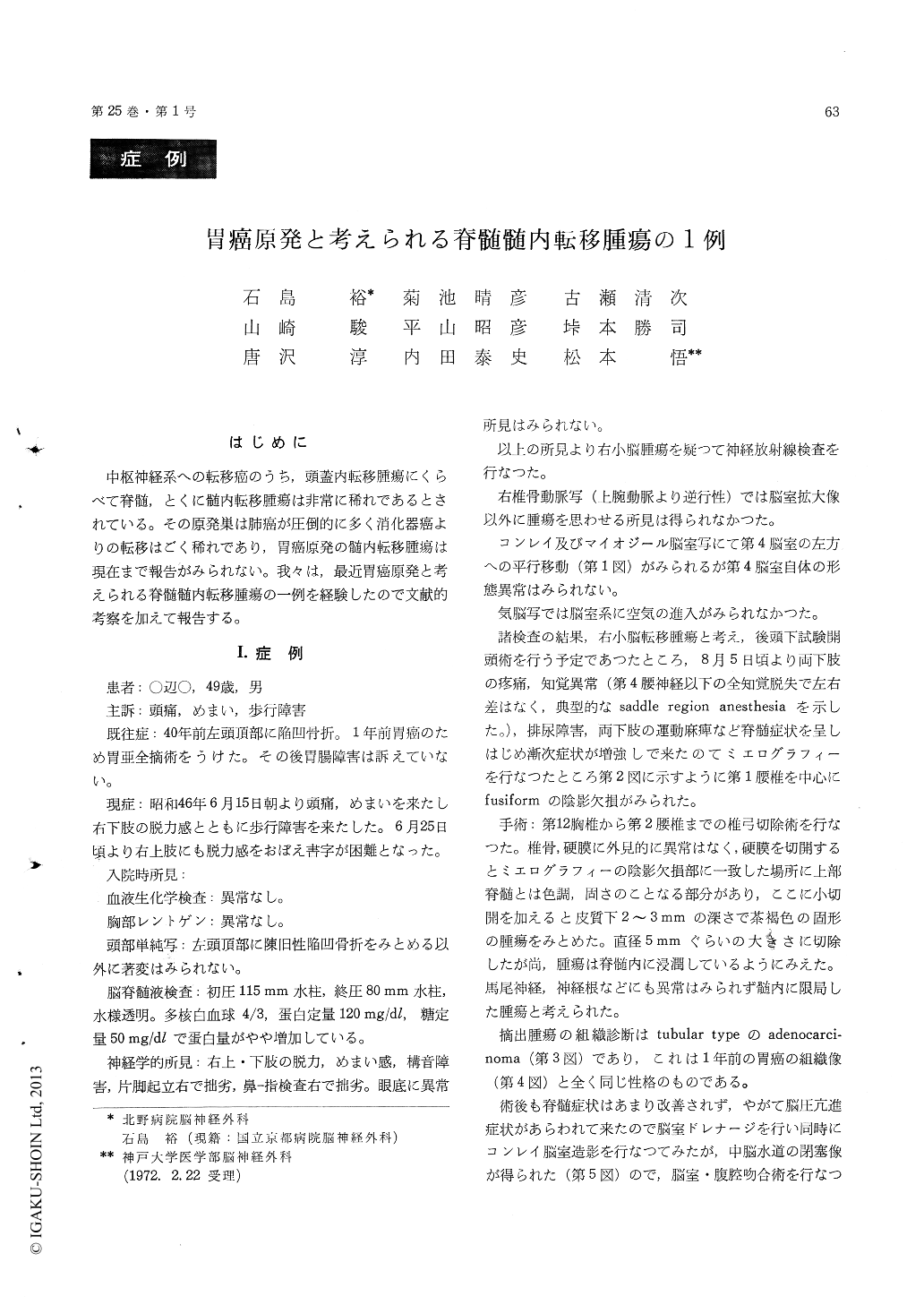Japanese
English
- 有料閲覧
- Abstract 文献概要
- 1ページ目 Look Inside
はじめに
中枢神経系への転移癌のうち,頭蓋内転移腫瘍にくらべて脊髄,とくに髄内転移腫瘍は非常に稀れであるとされている。その原発巣は肺癌が圧倒的に多く消化器癌よりの転移はごく稀れであり,胃癌原発の髄内転移腫瘍は現在まで報告がみられない。我々は,最近胃癌原発と考えられる脊髄髄内転移腫瘍の一例を経験したので文献的考察を加えて報告する。
We have reported a case of an intramedullary spinal cord metastatic tumor from stomach cancer.
A 49-year-old clerk, in whom an adenocarcinoma of the stomach had previously been adequately resected at the other hospital, manifested several cerebellar signs one year after the operation. Myosil ventriculography revealed the parallel shift of the fourth ventricle toward the left. In his course ofadmission, about 14 months after laparatomy, he suddenly developed spinal cord symptoms such as urinary disturbance, hypoesthesia according to the lumbar 3-4 dermatomes level on both sides and paraparesis. The sensory disturbance included characteristic saddle region anesthesia. A myelogram showed the f usiform filling defect in the conus medullaris indicating an intramedullary tumor. Laminectomy between the thoracic 12 and lumbar 2 and partial removal of the intramedullary spinal cord tumor were performed at once following the myelography. Vertebral bone, dura mata and nerve roots were intact. The patient, however, died 5 weeks after the operation. Autopsy could not be obtained. The tumor was an adenocarcinoma iden-tical with the primary lesion of the stomach.
In contrast to extramedullary metastases to the spine or the intracranial metastases, intramedullary spinal cord metastases are extremely rare. The pri-mary malignant tumors from which intramedullary metastases have been reported are carcinoma of the lung, breast, kidney, colon, chorioepithelioma, sarco-ma of the testicle, malignant melanoma and Hod-gikin's disease. Stomach cancer, however, has never been reported as the primary lesion of the intra-medullary metastatic spinal cord tumor anywhere. This presentation is the first case report in the world.
Following five routes of spread of tumor to sub-stance of the cord have been proposed ;
1) Arterial hematogenous spread, 2) Spread through the vertebral vein system, 3) Embolic spread through the subarachnoid spaces, 4) Lym- phogenous spread, and 5) Direct invasion. As to our case, it is probably true that the tumor made a deposit in the posterior fossa at first through whichever arterial or venous blood stream, and then it involved the spinal cord by the route of embolic spread through the subarachnoid space.
Symptomatology, diagnositc technique and thera- py of the intramedullary metastatic spinal cord tumors were discussed.

Copyright © 1973, Igaku-Shoin Ltd. All rights reserved.


